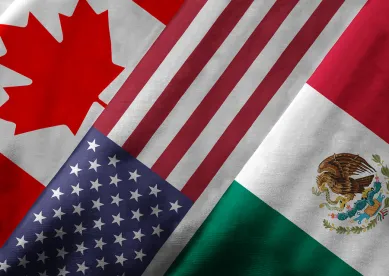On Monday, August 27, 2018, the United States Trade Representative (USTR) announced that the United States and Mexico have reached a preliminary agreement in principle, subject to finalization and implementation. The announcement was made via three Fact Sheets: Modernizing NAFTA to be a 21st Century Trade Agreement, Rebalancing NAFTA to Support Manufacturing, and Strengthening NAFTA for Agriculture. Notably, the text of the agreement has not been released. President Trump announced his intention to formally terminate the North American Free Trade Agreement (NAFTA) based on this handshake agreement.
Canada was not part of the negotiations that resulted in this new trade agreement and could be left out of the bloc. The Trump administration has indicated that Canada has until Friday, August 31, 2018, to sign on to the new trade deal. The Canadian Foreign Minister, Chrystia Freeland, then arrived in Washington to begin discussions with U.S. trade representatives. Observers expect that Canada will join the accord if provided the opportunity to negotiate, and Canada has stated that it will only sign an agreement it considers fair.
Some have argued that if NAFTA does indeed terminate, economic relations between Canada and the United States will not change much because both nations would fall back to the Canada-U.S. Free Trade Agreement (CUSFTA), implemented on January 1, 1989. However, since CUSFTA was superseded by NAFTA, some believe only an act of Congress can re-implement CUSFTA. As such, it is not certain whether CUSFTA would automatically be in effect if NAFTA is terminated.
Modernizing NAFTA to Be a 21st Century Trade Agreement
Based on the details released, the new agreement struck with Mexico aims to strengthen intellectual property rights for the 21st century, adding enforcement mechanisms for theft, or suspected theft, of intellectual property. The agreement will also include a new Digital Trade chapter that will provide a foundation for investment in innovative products and services in order to maximize the competitive advantage the United States has in that space.
Further, this agreement is set to increase the de minimis shipment amount from $50 to $100 for imports into Mexico. This is important to retailers that believe such an increase will facilitate cross-border e-commerce trade. Interestingly, some of the provisions that concern e-commerce and digital trade were already negotiated by the United States, Mexico and Canada under the Trans-Pacific Partnership. As such, this chapter on Digital Trade should not be controversial because all three countries had agreed to them previously.
Rebalancing NAFTA to Support Manufacturing
The agreement will incentivize goods and materials sourced in North America, particularly in the United States. For example, the administration, through this agreement, intends to increase U.S. manufacturing by requiring that 75 percent of auto content be made in the U.S. and Mexico, and that 40 to 45 percent of auto content be made by workers earning at least $16 per hour. Note, however, that USTR has not indicated that these heightened content and wage requirements would apply to any sector other than the automotive sector, nor provided details on its calculation or enforcement. There have also been reports suggesting that the agreement will allow a U.S. president to impose additional 25 percent national security tariffs on Mexican cars and sport utility vehicles imported annually above 2.4 million vehicles. The deal would also allow duties, based on national security, to be imposed on auto parts imported from Mexico annually above $90 million. However, details have not been released on these quota restrictions.
The deal also aims to update the Rules of Origin and Origin procedures to incentivize greater U.S. and Mexican production in textiles and apparel, strengthen customs enforcement, and facilitate broader consultation and cooperation among the parties on these issues. The updated Rules of Origin and Origin procedures will cover specific manufacturing sectors, including Information and Communications Technology, Pharmaceuticals, Medical Devices, Cosmetic Products, and Chemical Substances. Again, only high-level outlines have thus far been released.
Details have not yet emerged concerning whether this new agreement will impact Section 232 duties on steel and aluminum. Some commentators have expressed the view that duties are likely to be replaced by quotas on imports of Mexican steel and aluminum that are currently subject to the Section 232 proceeding, similar to the quota mechanism that the U.S. government has put in place with other countries.
Strengthening NAFTA for Agriculture
The agreement will maintain duty-free treatment on agricultural products, and will set new standards on agricultural biotechnology on top of enhancing rules on science-based sanitary and phytosanitary measures. The administration claims that these measure are focused on American farmers, ranchers and agribusinesses.
Further, the agreement will include geographical indication standards and will not restrict market access in Mexico for U.S. cheeses labeled with certain names. Particularly, both countries will recognize Bourbon Whiskey, Tennessee Whiskey, Mezcal and Tequila as protected geographical indications.
The administration’s heretofore escalating trade disputes with Mexico, Canada, China and the European Union have significantly decreased prices for soybeans, pork, corn and other farm products. To address that, on August 27, 2018, the U.S. Department of Agriculture (USDA) announced that it will authorize $12 billion in aid to assist U.S. farmers who have been affected by the trade dispute. While this aid has been welcomed, stakeholders are eagerly awaiting the text of the new agreement announced by USTR to see whether it will be a step forward or backwards from NAFTA.









 />i
/>i
